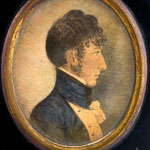Portrait Miniature of Trafalgar Officer - Lieutenant Benjamin Patey, R.N.,1805
Adding product to your cart
Oval: 84mm x 68mm
Watercolour on paper. Patey is shown in profile looking left and wearing the full dress uniform of a Royal Navy lieutenant of the period 1795-1812. Glazed and contained within a gilt metal oval mount and set within in a period ebonised frame with oak leaf and acorn suspension loop. An old paper label to the reverse inscribed ‘Benjamin Patey / born in Devonshire, 1784 [sic] / First [sic] Lieutenant on the / Mars at Trafalgar / Nancy’s Great-great grandfather’.
Benjamin Patey was present off Cape Trafalgar on 21 October 1805 as a lieutenant in H.M.S. Mars, and doubtless joined the crew in cheering the headless corpse of Mars’s Captain Duff when he was paraded around the quarterdeck to show they were not discouraged.
Read more
Patey was one of nine brothers all of whom joined the navy. He was born at Stonehouse, Plymouth on 12 March 1782. His father George was a Gunner in H.M.S. Warrior and at the time of Benjamin’s birth was serving with Rodney’s fleet in the West Indies. Benjamin entered the navy at the age of thirteen and was appointed to H.M.S. Terrible (74 guns) with the rate of ‘Servant’ to his brother Lieutenant Charles Patey who like all his siblings rose soley due to personal merit. Rated ‘Volunteer’ shortly afterwards, Benjamin Patey was present in Terrible at Hotham’s indecisive fleet actions off Genoa (in which the brunt of the fighting was borne by Captain Horatio Nelson) and the Hyères Islands, which though potentially decisive, Nelson derided as ‘a miserable action’. Patey experienced his first shipboard mutiny in Terrible in the same year and subsequently took part in the unsuccessful pursuit of Admiral Richery’s squadron after it eluded the Toulon blockade.
Appointed Midshipman in 1797, Patey was in Terrible when the lower deck succumbed to
the widespread mutiny at Spithead. The next year he participated in the interception of Admiral Bompart’s fleet off Donegal and in the pursuit of Commodore Savary’s squadron seeking to aid the doomed Irish rebellion. During the chase Terrible under the command of Sir Richard Bickerton had her mizzen-mast severely damaged by enemy fire and had her fore and maintop sails, and top gallant yards carried away by a sudden squall as Terrible was clearing for action. This ill-luck combined Savary’s thoroughness in throwing guns, horses and stores overboard allowed the French to escape to Brest. In 1800 Patey was present with squadron from Channel fleet that silenced the forts at Quiberon and in Captain Pellew’s blockade of Lorient.
In 1801 Patey was employed in the despatch vessel Wolverine (14 guns) until paid off at Portsmouth in April 1802. After a short spell on half-pay he was appointed to Captain George Duff’s H.M.S. Mars (74 guns), wherein his nephew George Edward Patey was numbered amongst the midshipmen. In 1805 as part of Nelson’s Mediterranean Fleet and as a unit of the cordon of communication between the frigate Euryalus and the flagship Victory, Patey’s ship was one those that passed the news that the enemy was coming out of Cadiz. At Trafalgar on 21October Mars was heavily damaged by fire from five different French and Spanish seventy-four gun ships. A cannonball from Fougueux raked the quarter-deck and struck Captain Duff at the base of the neck, severing his head completely. The crew were undismayed and carried the headless corpse around the deck and giving three cheers in memory of their captain, before replacing him where he fell and covering him with a Union Flag. Casualties among Patey’s shipmates amounted to 29 killed and 69 wounded.
Patey’s next important service was in Mars at the capture of the French ship Rhin (42 guns) off Rochefort in July 1806 after a pursuit of 150 miles and in the face of a one sided fight with four French sail-of-the-line. Later the same year he was present in the action against Commodore Soleil’s squadron which had broken out of Rochefort and in which Mars forced the Gloire (40 guns) to haul down her colours after a running fight.
Benjamin Patey next sailed in Mars with fleet under Admiral Gambier to take part in the Bombardment of Copenhagen after which the Danish fleet was surrendered to Great Britain. After bringing the Danish ship Fyen (74 guns) to England, Mars returned to the Baltic to participate in operations against Russia which was now allied with France. In company with H.M. Ships VIctory, Goliath and Africa, Mars reinforced in the Anglo-Swedish blockade of a Russian squadron held at bay for several months in Ragerwik. In early 1809, however, Patey succumbed to effects of his long service and ‘over-work in excessively rigorous weather’. On 9 January while off Gottenberg, he was transferred from Mars to the hospital ship Gorgon, where he died shortly afterwards of ‘fever’, leaving a widow whom he had married a few months before the Battle of Trafalgar, and an only daughter.
Source:
Harvey, C. (1909) ‘The Naval History of The Patey Family, Privately Printed, Witney






